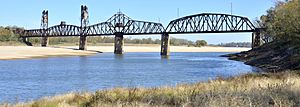Yancopin Bridge facts for kids
Quick facts for kids Yancopin Bridge |
|
|---|---|

View from south bank of Arkansas River
|
|
| Coordinates | 33°57′19″N 91°12′22″W / 33.955304°N 91.206075°W |
| Locale | Watson, Arkansas |
The Yancopin Bridge is an old railroad bridge that no longer carries trains. It crosses the Arkansas River. It's the very last bridge on the Arkansas River before it joins the big Mississippi River, about 15 miles away. This bridge is special because it's huge and in a quiet, faraway spot. It also had two parts that could move! One movable part was built after the river changed its path.
The Yancopin Bridge was built by a company called the Memphis, Helena & Louisiana Railway. This company was part of a bigger railroad known as the St. Louis, Iron Mountain and Southern Railway, or "Iron Mountain" for short. Later, Iron Mountain joined with the Missouri Pacific Railroad. The bridge has a single track and is made of metal. It's a type of truss bridge, which means it uses a strong framework. It also had a special part that could lift up, called a lift span. Long wooden ramps, called trestles, led up to the bridge on both sides.
Contents
A Look Back: The Bridge's Story
The Yancopin Bridge was finished in 1903. However, the train track it served didn't open until March 1, 1906. Over the years, floods often changed the Arkansas River's path. This meant the bridge needed many repairs and changes.
Changes to the Bridge
After World War II, a new part was added to the bridge. This was a swing span, which could turn open like a gate. It was needed because the river's main channel, where boats traveled, had moved away from the original lift span. Some old magazines from the Missouri Pacific railroad said this bridge might have been the most expensive one on their whole system!
Passenger Trains and the Delta Eagle
On May 11, 1941, the Missouri Pacific railroad started a new train called the Delta Eagle. This was their first modern, diesel-powered train in Arkansas. It traveled between Memphis, Tennessee and Tallulah, Louisiana, crossing the Yancopin Bridge.
This train route was very busy during World War II. But after the war, fewer people rode the train. By October 27, 1954, the train service was much shorter. It only went between McGehee, Watson, Yancopin, and Helena. Sometimes, a special streamlined motorcar called the Eagle (motor 670) was used for this trip. Passenger train service over the Yancopin Bridge stopped completely on February 27, 1960.
The Bridge's Final Years as a Railroad Bridge
In April 1980, the Missouri Pacific railroad began to improve its line between McGehee and Paragould. They wanted to move trains carrying chemicals away from busy cities like Little Rock. They installed new tracks, signals, and fixed many bridges. By early 1981, chemical trains started using this new route, including the Yancopin Bridge.
However, this didn't last long. In December 1982, the Missouri Pacific railroad joined with the Union Pacific Railroad. The new Union Pacific company decided that the route over the Yancopin Bridge was no longer needed. So, the chemical trains went back to the old route through Little Rock. Parts of the railroad north of McGehee were closed down and later abandoned.
What Happened to the Bridge?
In 1992, Union Pacific stopped using the Yancopin Bridge. They gave the bridge and 73 miles of old railroad land to the State of Arkansas. This land became part of the Delta Heritage Trail State Park.
The Arkansas State Highway and Transportation Department now takes care of the bridge. The swing span is still opened and closed by hand for logging boats on the river for several months each year.
Nature Around the Bridge
The area around the Yancopin Bridge is full of amazing wildlife. You might even see rattlesnakes there! North of the bridge, the old rail line (which is now a trail) goes through a very old hardwood forest. This forest is part of the Trusten Holder State Wildlife Management Area.
You can get to the bridge from Watson, Arkansas, by taking County Road 41.

